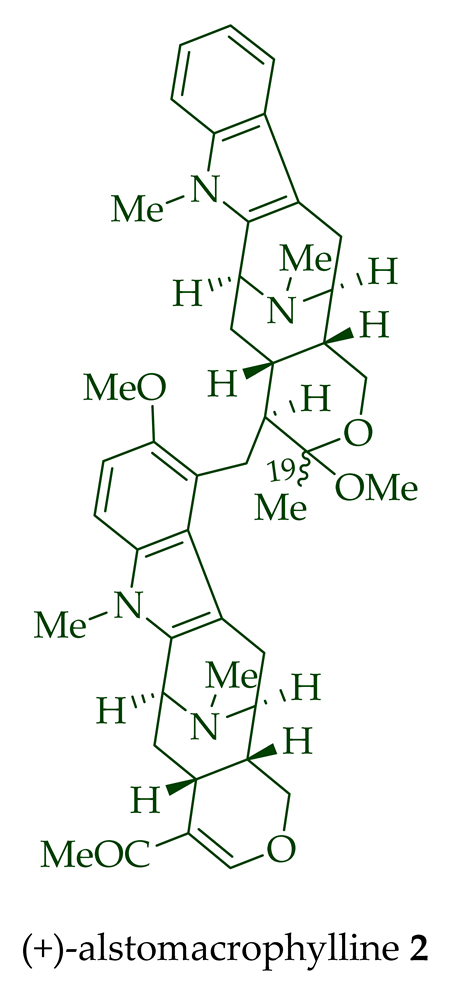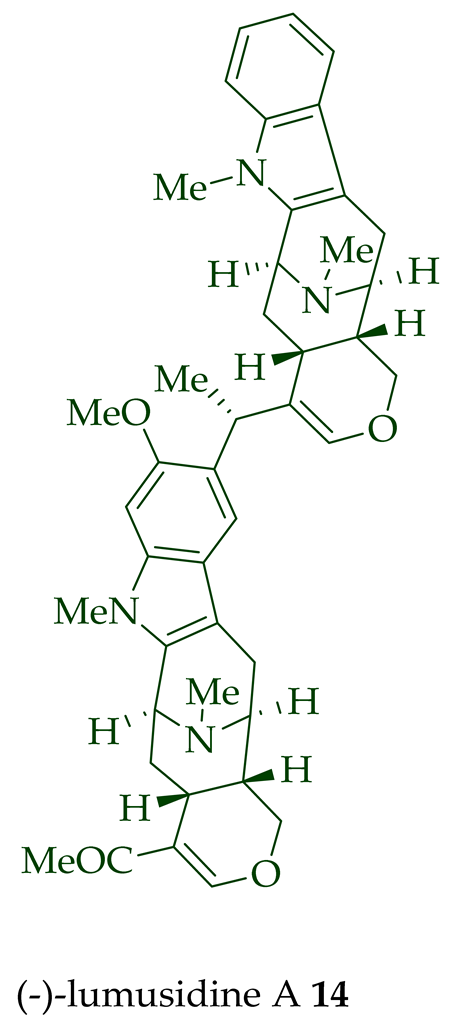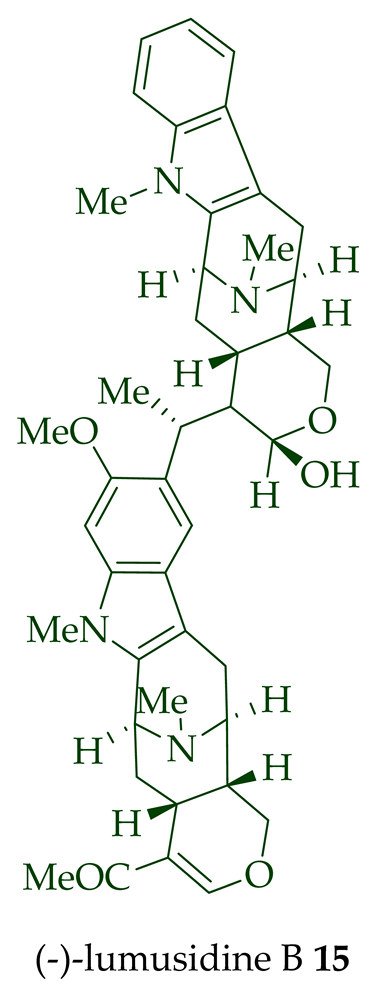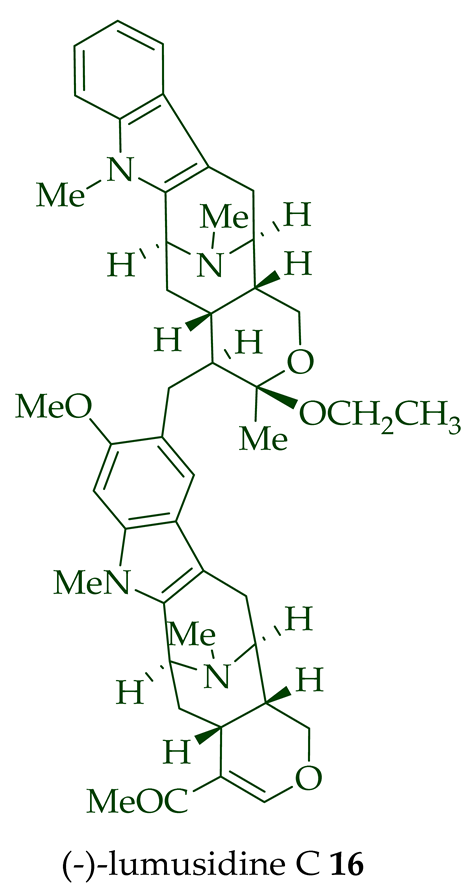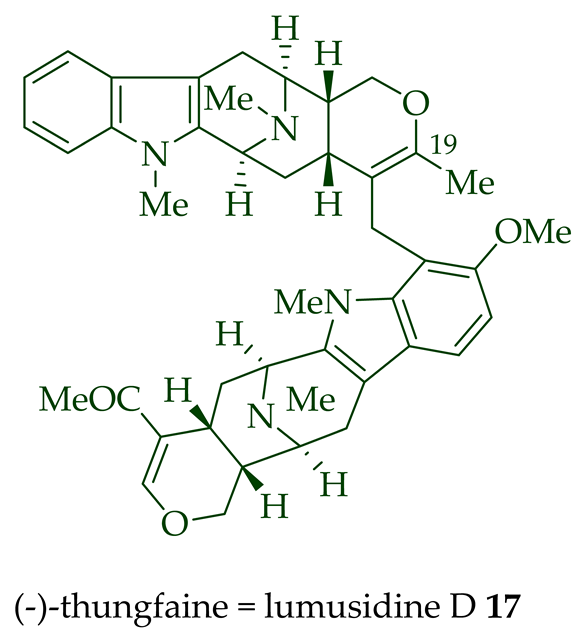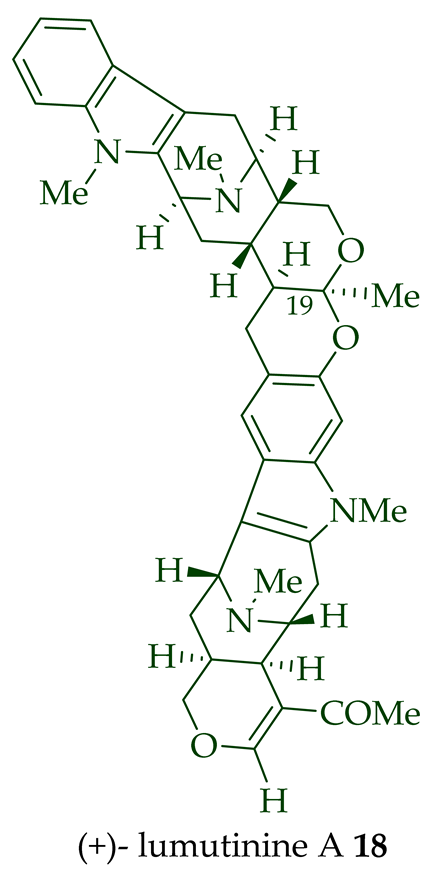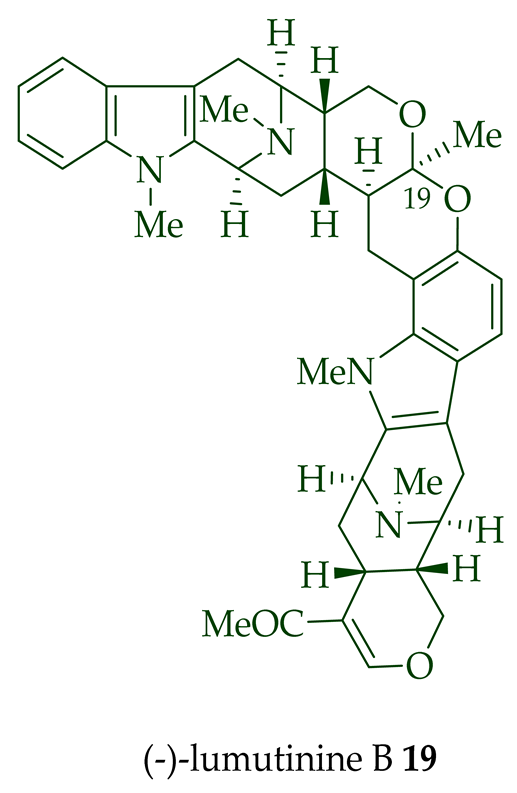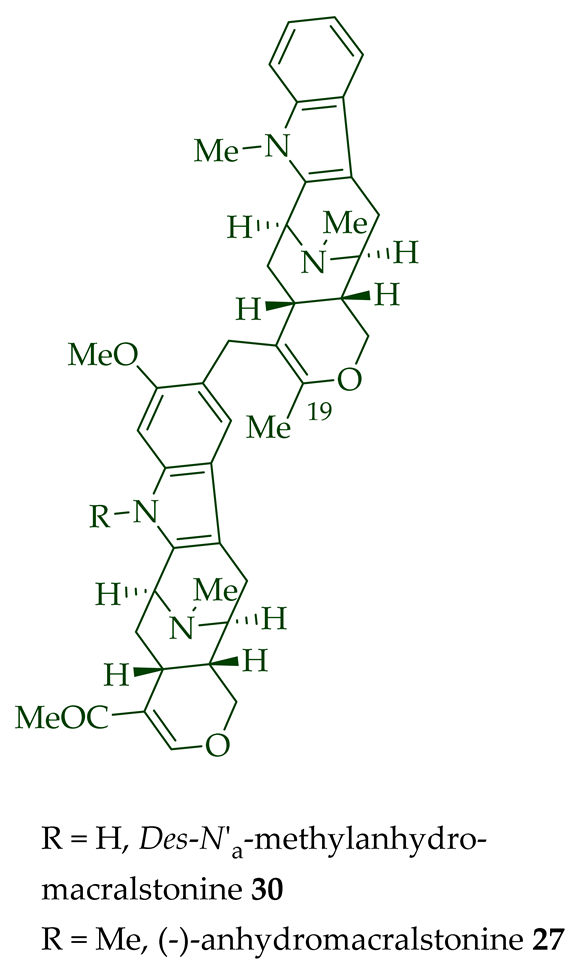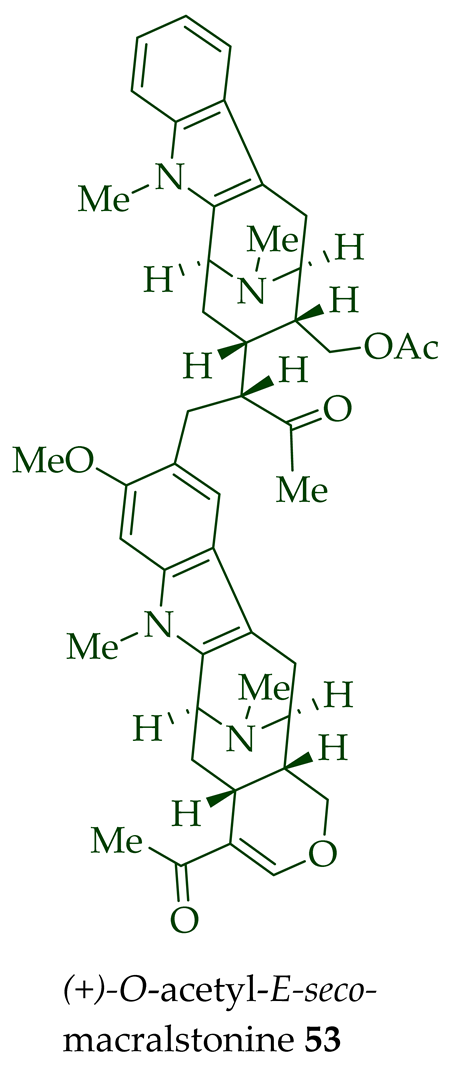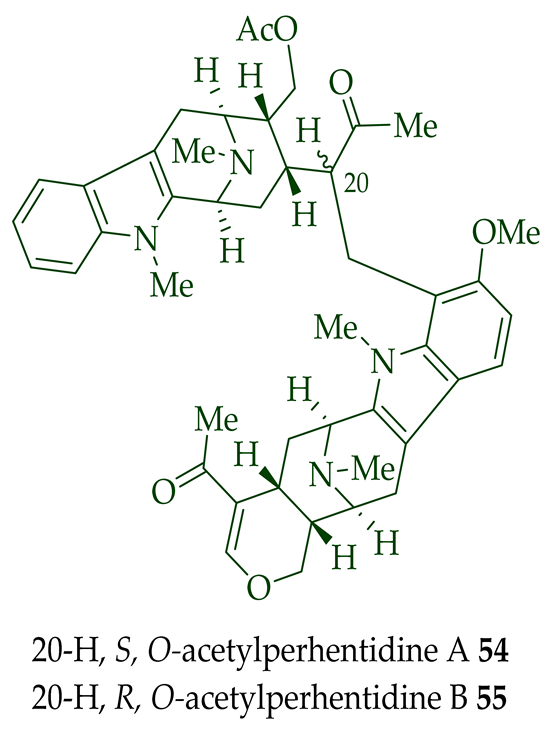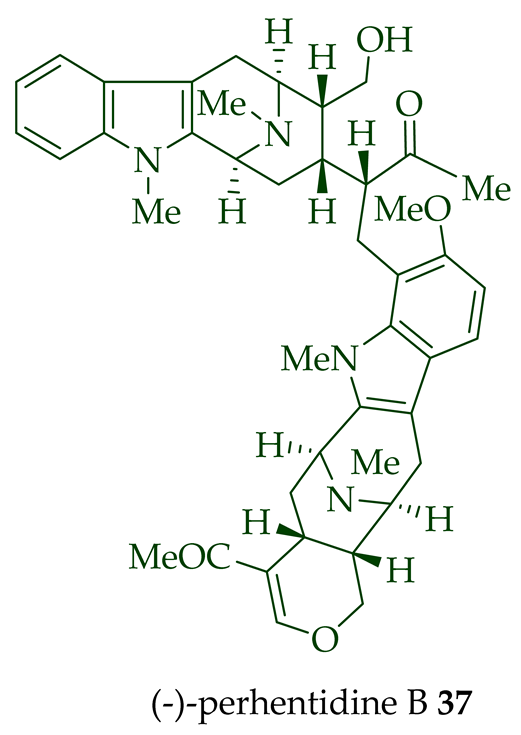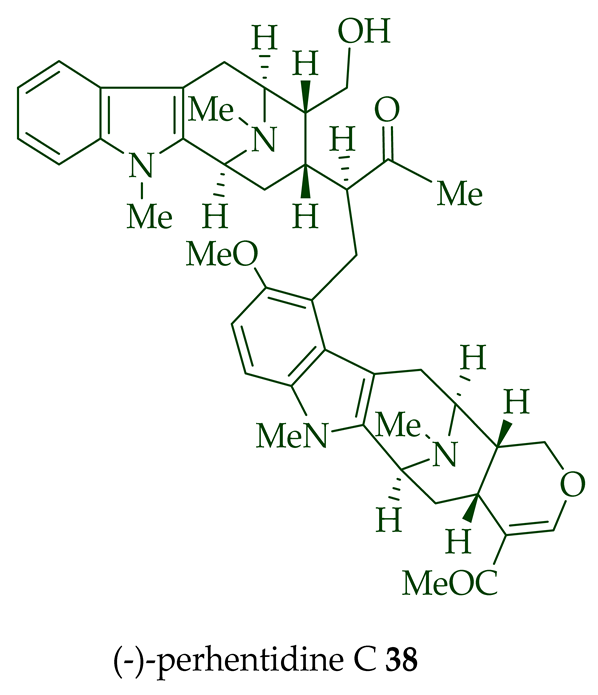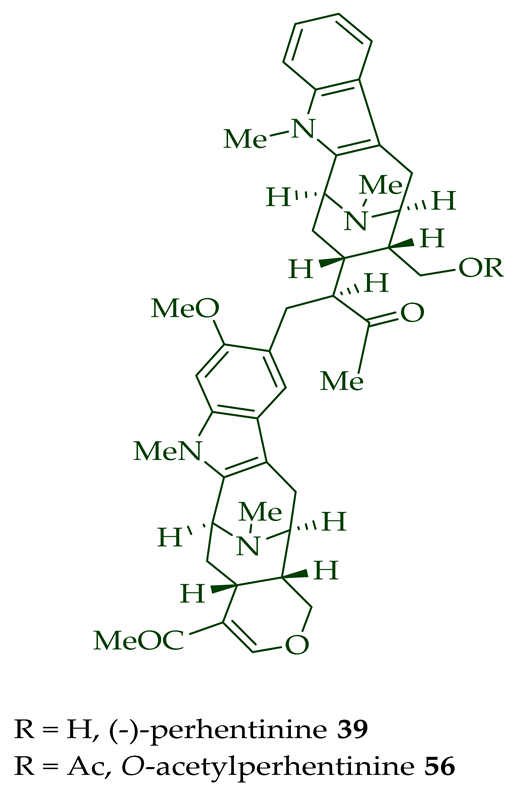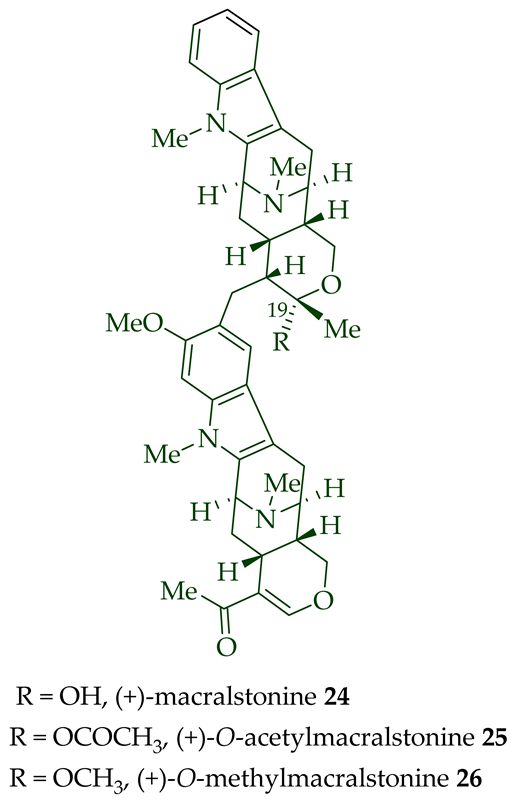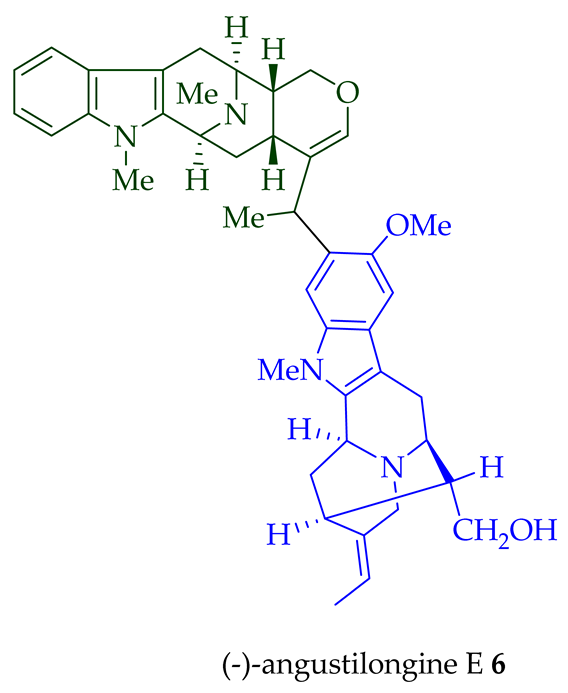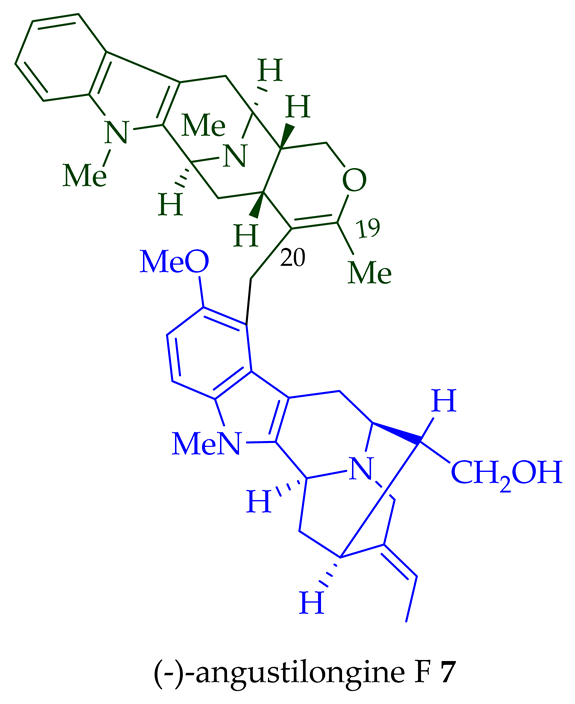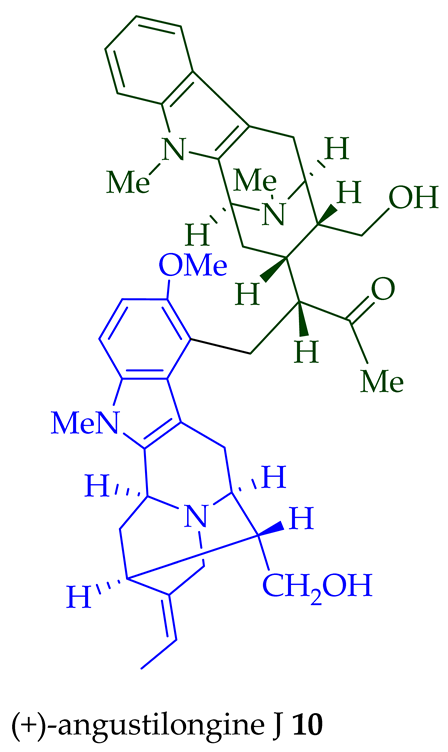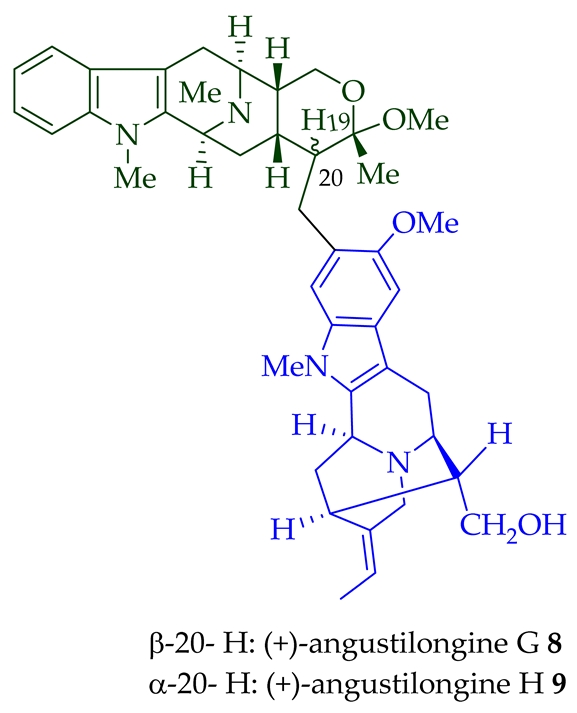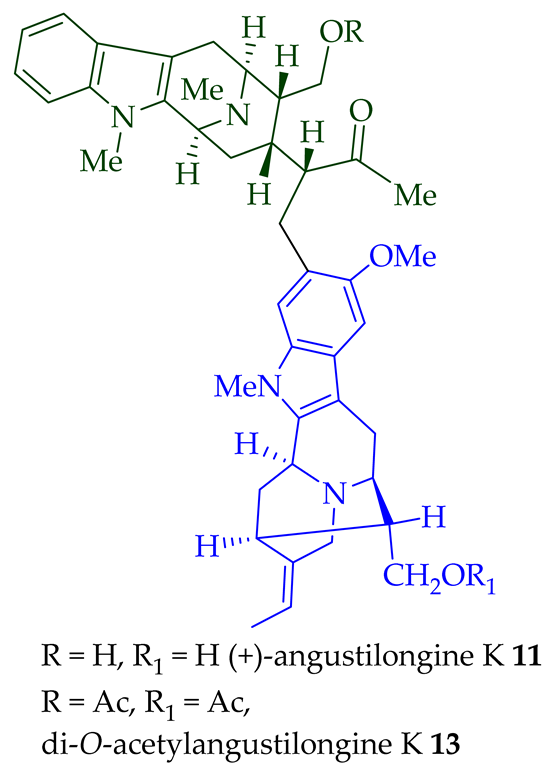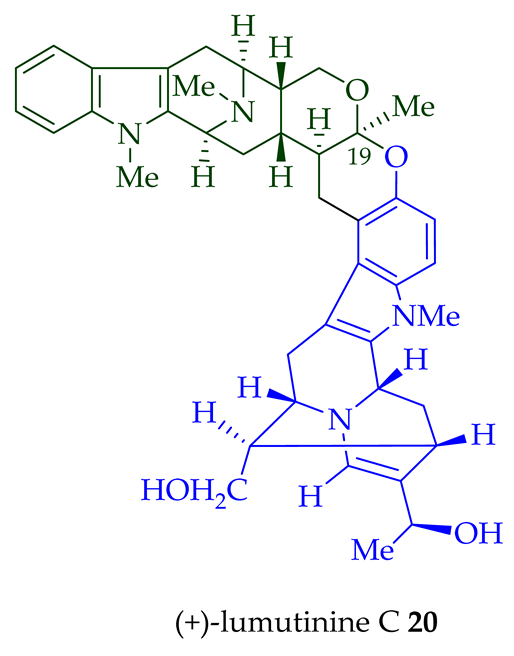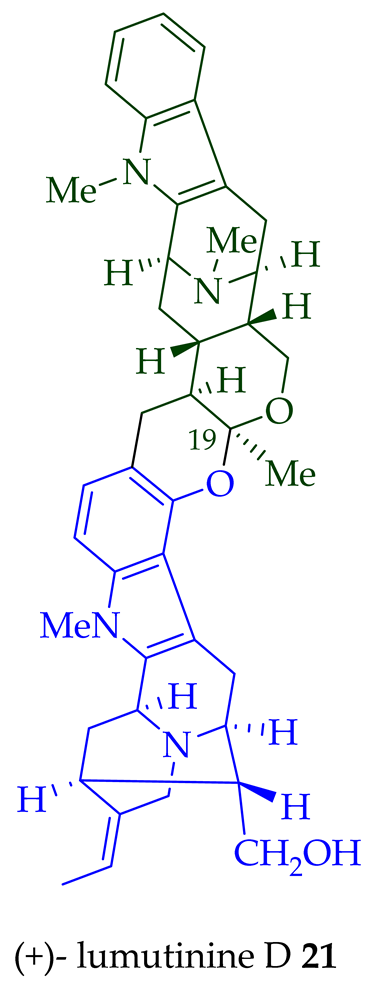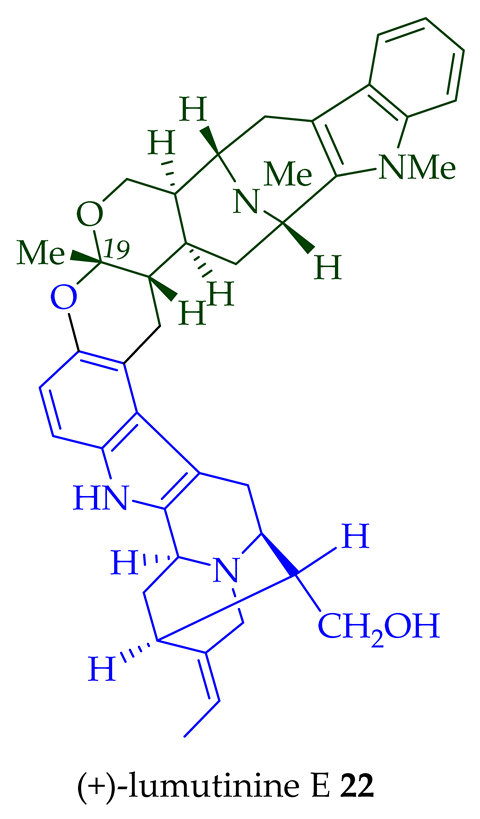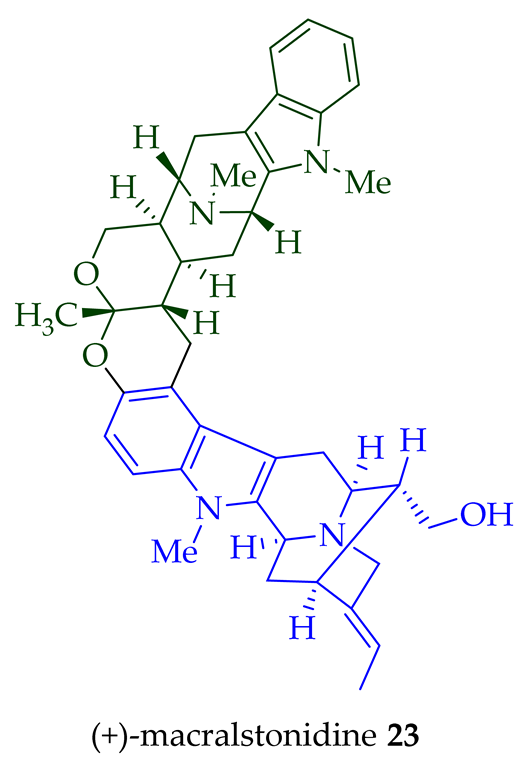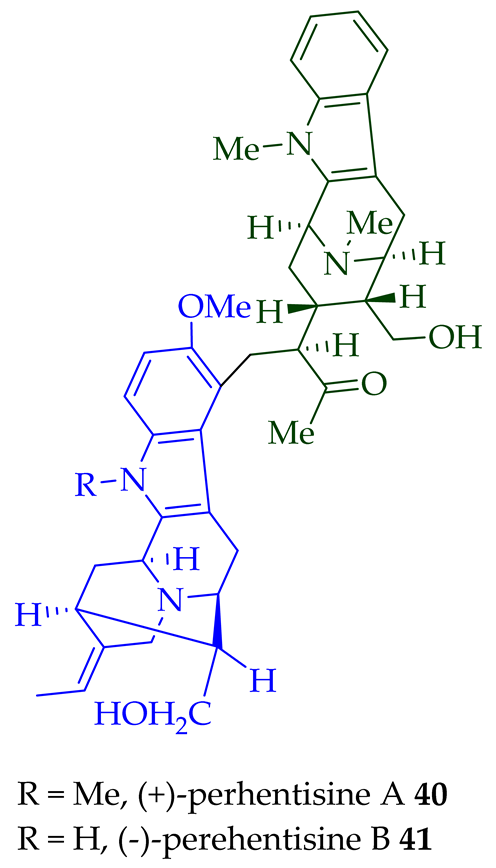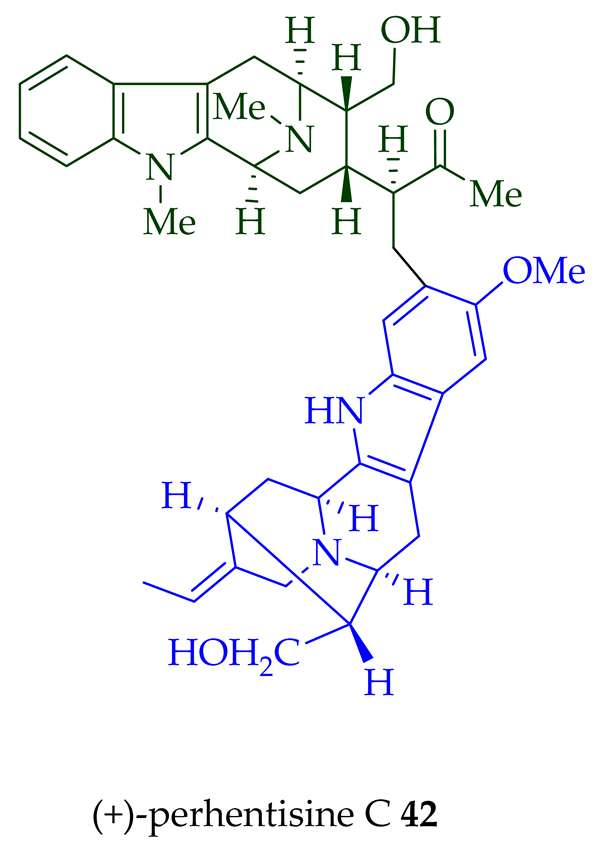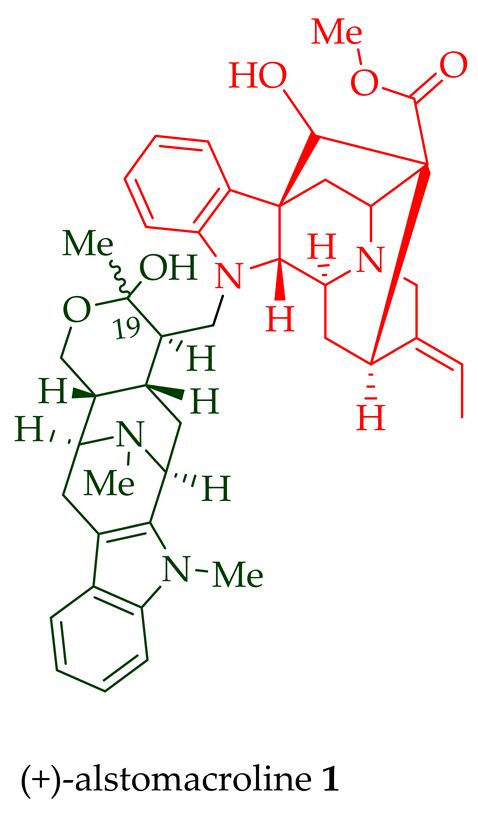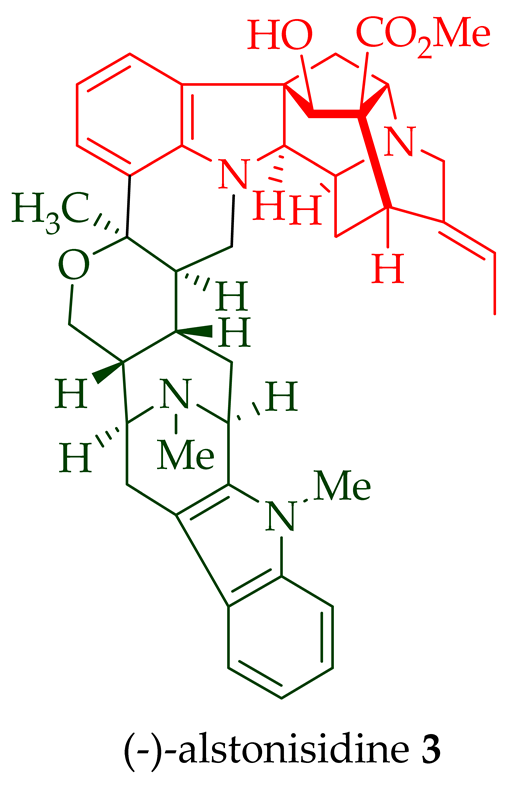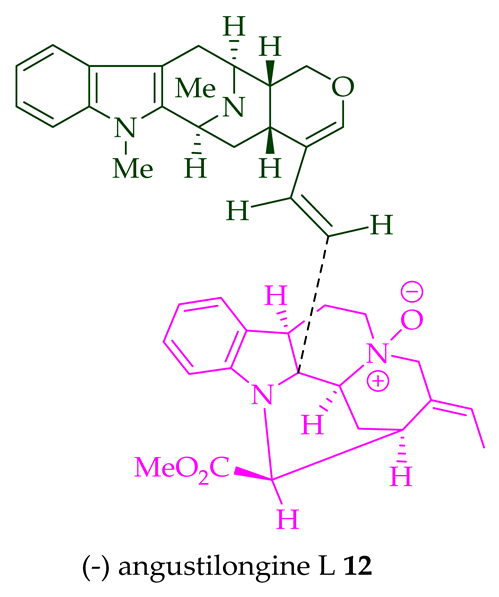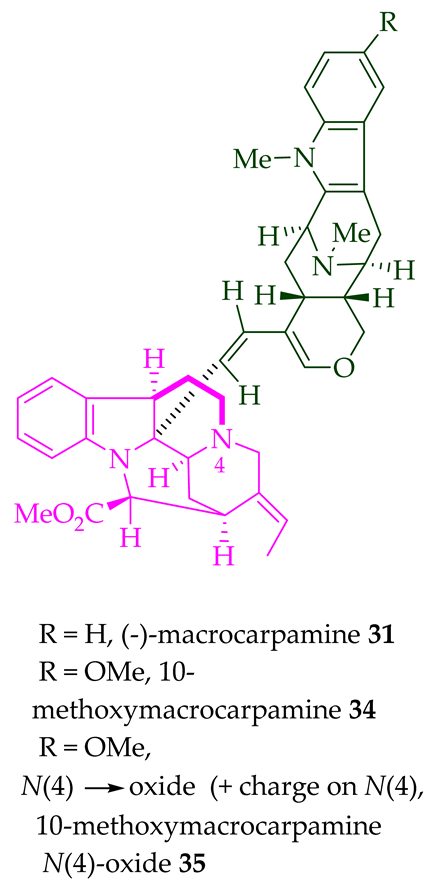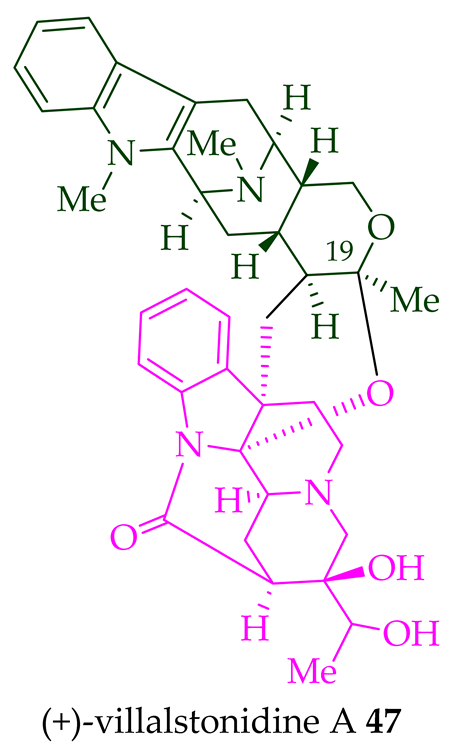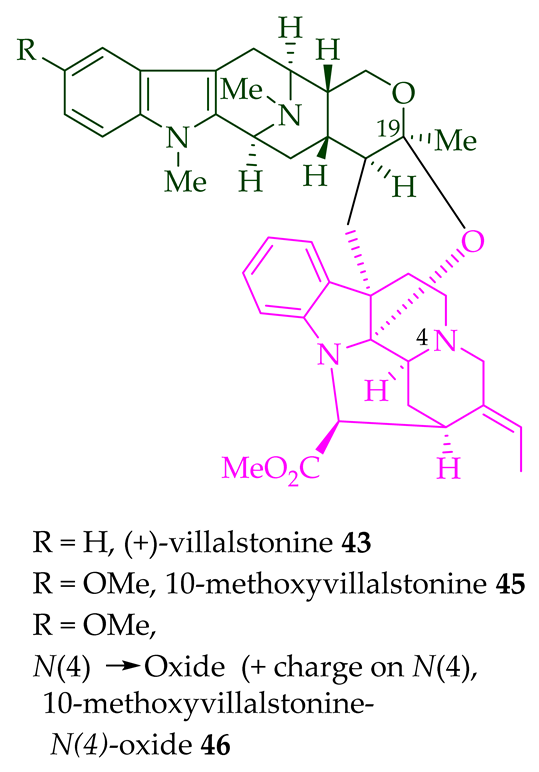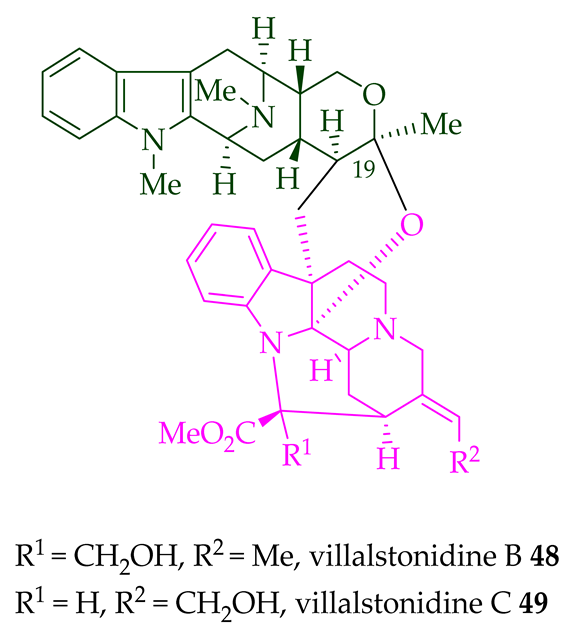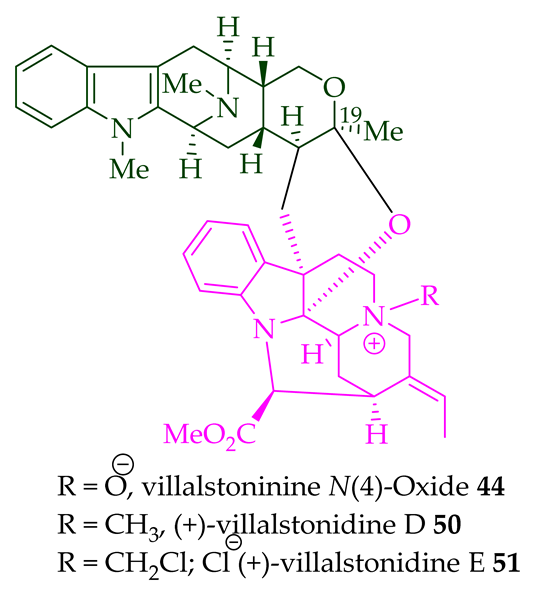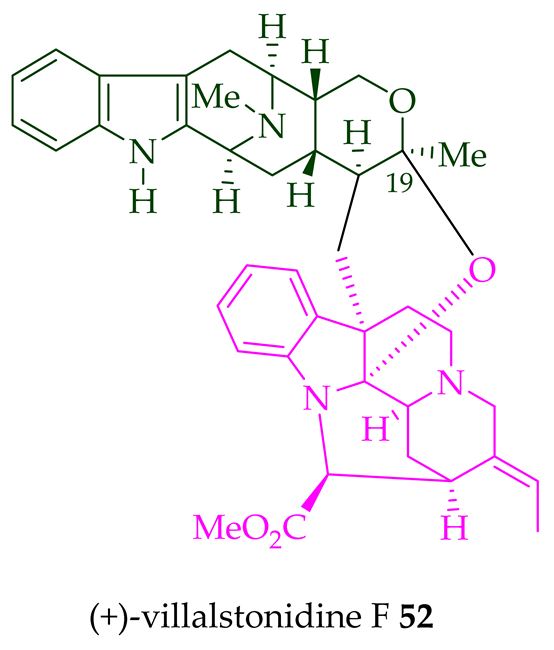Bisindoles are structurally complex dimers and are intriguing targets for partial and total synthesis. They exhibit stronger biological activity than their corresponding monomeric units. Bisindole alkaloids are naturally occurring alkaloids containing two indole nuclei and are the products of late-stage biosynthetic processes in higher plants by combining two monomeric units. Depending on the monomeric units involved, bisindoles can be a homo- or heterodimer. As a result, bisindole alkaloids comprise much higher structural complexity than both of the monomeric units that comprise them.
Alstonia
, a major genus in the Apocynaceae family of plants, has more than 150 species and is found all over the world. Robert Brown named it in 1811 in honor of Charles Alston (1685–1760), an eminent botanist at the University of Edinburgh. The
Alstonia
genus’ trees and shrubs are prevalent in the tropical and subtropical parts of Africa, Asia, and Australia. They contribute significant pharmacological activity, including anticancer, antileishmanial, antimalarial, antitussive, antiviral, antiarthritic, and antibacterial activities.
1. Bisindole Alkaloids in drug discovery
Nature has been a substantial and sustainable pool of biologically active compounds. Since ancient times natural product extracts (in crude form) have been used in traditional and folk medicines in many countries. In modern times pure (isolated) natural products and their derivatives play an important role in drug discovery, as indicated by their prevalence in approved drugs for clinical use. Out of the 1881 newly FDA-approved drugs over the last four decades (1 January 1981 to 30 September 2019), a significant portion comprising 506 (26.9%) were either natural products or derived from or inspired by natural products [1]. It is expected that the advent of modern and innovative technologies such as computational software, cheminformatics, artificial intelligence, automation, and quantum computing will further boost natural product-based drug discovery. A synergy among these technological milestones would accelerate hit to lead to clinic pathways of drug discovery, and natural products are expected to remain an important source [2]. Moreover, pharmacophores and their unique stereochemical interactions with natural products may stimulate more demanding targets such as protein–protein interactions in the near future and open up a new avenue in modern drug discovery [3]. The majority of biologically active natural products are produced in plants, known traditionally as medicinal plants. Alkaloids, the most important class of natural products with structural diversity and significant pharmacological effects, are mainly found in higher plants such as the Apocynaceae, Ranunculaceae, Papaveraceae, and Leguminosae families [4]. These natural products, along with flavonoids, fatty acids, etc., are the major classes of secondary metabolites that are believed to be parts of the plants’ defense mechanism. To date, many monoterpenoid indole and bisindole alkaloids have been found in the Alstonia genus [5]. Modern clinical application of many of these alkaloids are similar to their traditional or folklore applications; for example, cocaine and morphine were used as anesthetics while caffeine and nicotine were used as stimulants [6]. Recently, Fielding et al. illustrated that several anti-coronavirus alkaloids showed potential therapeutic value against severe acute respiratory syndrome coronavirus-2 (SARS-CoV-2) in their in silico studies [7].
The indole motif is present in many naturally occurring and biologically active compounds. Some of them have been used in the clinic. In addition, there are numerous examples of synthetic compounds with useful medicinal properties that bear the indole moiety. Consequently, the indole scaffold is one of the few “privileged structures” in modern medicinal chemistry and drug discovery
. The prevalence of bioactivity of indole-containing molecules may be attributed to their similarity to the essential amino acid tryptophan, as well as important biomolecules such as tryptamine and serotonin. Many plant extracts, which likely include alkaloids, have been used from time immemorial in folk medicines for fever, general weakness, dysentery, pain, liver diseases, gastrointestinal diseases, and cancer
. Currently, there are many indole alkaloid-based marketed drugs such as sumatriptan for the treatment of migraine; vincristine and vinblastine for the treatment of various cancers, including leukemia and lung cancer; as well as reserpine for the treatment of hypertension and to decrease severe agitation in patients with mental disorders
.
More structural diversity can be achieved via bisindole-based drug discovery by changing both monomeric units to furnish unnatural and
pseudo
-natural alkaloids. As such, bisindole alkaloids offer a large pool of natural, semi-natural, and chimeric drug candidates that have greater drug-like characteristics. As a result, due to their important biological applications and complex structural features, bisindole alkaloids have engendered the profound interest of synthetic organic and medicinal chemists, computational chemists, and chemical biologists.
2. Isolation and Plant' Morphology of Bisindoles from Alstonia Species
Among various species of the Alstonia
genus, A. macrophylla
and A. angustifolia
are the two major sources of bisindole alkaloids discussed herein (vide infra
, ). (+)-Alstomacroline 1
, a bisindole alkaloid consisting of a macroline and an ajmaline unit (monomeric units not shown here: please visit https://doi.org/10.3390/molecules26113459
for details), was isolated from the bark of A. macrophylla
[12]
and the leaves, stem-bark, and root-bark extracts of A. scholaris, A. glaucescens, and A. macrophylla[13][14]
. (+)-Alstomacrophylline 2
(macroline–macroline-type) was isolated from the bark of A. macrophylla
[12]
and the leaves, stem-bark, and root-bark extracts of A. scholaris, A. glaucescens, and A. macrophylla
[14]
. (-) Alstonisidine 3
, which contains a quebrachidine and a macroline unit, was isolated from the bark of A. muelleriana
[15][16]
. The structure of (-)-alstonisidine 3
was confirmed by X-ray crystallographic data [17]
. Yeap et al. recently isolated seven novel bisindoles from the methanol extract of the stem-bark of Malayan A. penangiana
[18]
. This includes (-)-angustilongine E 6
, (-)-angustilongine F 7
, (+)-angustilongine G 8
, (+)-angustilongine H 9
, (+)-angustilongine J 10
, (+)-angustilongine K 11
, and (-)-angustilongine L 12
(macroline–pleiocarpamine type). (+)-Angustilongine K 11
was converted into (+)-di
-O
-acetylangustilongine K 13
by stirring it with 10 equivalents of pyridine and 15 equivalents of acetic anhydride for 6 h at room temperature in 95%
yield [18]
. Among those, angustilongine G 8
and angustilongine H 9
are C-19 methyl substituted [19]
bisindoles. The structures of the angustilongines were confirmed by various spectroscopic data, including 1
H NMR, 13
C NMR, 2D NMR, IR, and HRMS by Yeap et al. [18]
. Angustilongine E 6
, angustilongine F 7
, angustilongine G 8
, angustilongine H 9
, angustilongine J 10
, and angustilongine K 11
are macroline–sarpagine coupled bisindoles. Angustilongine G 8
and angustilongine H 9
differ in stereochemistry only at the C-20 position.
Two macroline units are contained in (-)-lumusidine A 14
, (-)-lumusidine B 15
, (-)-lumusidine C 16
, and (-)-lumusidine D 17
bisindoles. They were isolated from the stem-bark of A. macrophylla
and the structures were confirmed via NMR spectroscopy, mass spectrometry, UV spectroscopy, and X-ray crystallography [12]
. After isolation, the group of Kam et al. converted oily (-)-lumusidine A 14
, (-)-lumusidine B 15
, and (-)-lumusidine D 17
into the corresponding crystalline dimethyl diiodide salts (structures not shown) by treatment with an excess of iodomethane for 24 h. The crystalline salts were employed to obtain X-ray crystallographic data to elucidate the exact stereochemical confirmation [12]
. (-)-Lumusidine D 17
is also known as thungfaine [20]
. (+)-Lumutinine A 18
, (-)-lumutinine B 19
, (+)-lumutinine C 20
, and (+)-lumutinine D 21
are linearly fused bisindoles isolated from the stem-bark of A. macrophylla
as a light yellowish oil [21]
. (+)-Lumutinine A 18
and (-)-lumutinine B 19
are macroline–macroline-type bisindoles, while (+)-lumutinine C 20
, (+)-lumutinine D 21
, and (+)-lumutinine E 22
are macroline–sarpagine-type bisindoles. The structures of the lumutinines were elucidated using spectroscopic means including 1D and 2D NMR, IR, as well as mass spectrometric analysis [21]
. The structure of (+)-lumutinine D 21
was confirmed by X-ray crystallographic data [22]
. (+)-Lumutinine E 22
, a macroline–sarpagine-type bisindole, was isolated from the stem-bark of A. angustifolia
[23]
.
(+)-Macralstonidine 23
(macroline–sarpagine-type) was isolated from the bark of A. macrophylla
[24][25]
, as well as from A. somersentenis
[24]
and A. spectabilis
[26]
. (+)-Macralstonine 24
was isolated from the leaves, stem-bark, and root-bark extracts of A. scholaris, A. glaucescens, and A. macrophylla
extracts [14]
, A. macrophylla
[24][25][27][28][29]
, A. muelleriana
[30]
, A. angustifolia
[31]
, as well as from A. glabriflora
[26]
. The structure of (+)-macralstonine 24
was confirmed by various NMR spectroscopy, mass spectrometry, and X-ray crystallography [28]
. The (+)-macralstonine 24
-related bisindole, (+)-O
-acetylmacralstonine 25,
was isolated from the leaves, stem-bark, and root-bark extracts of A. scholaris, A. glaucescens, and A. macrophylla
[14]
. Also, (+)-O-
methylmacralstonine 26
was isolated from the leaves, stem-bark, and root-bark of A. scholaris, A. glaucescens, and A. macrophylla
extracts [14]
. (-)-Anhydromacralstonine 27
was isolated from the stem-bark of A. angustiloba
[23]
and contains (-)-alstophylline and (+)-macroline as monomeric units. Another (-)-alstophylline 28
and (+)-macroline monomeric bisindole, (+)-Des-N’a
-methylanhydromacralstonine 30,
was isolated from the bark of A. muelleriana
[14][30]
, the stem-bark of A. angustifolia
[28]
, and A. glabriflora
[26]
. (+)-Macrocarpamine 31
, a hetero-dimeric bisindole containing a (+)-pleiocarpamine and (-)-anhydromacrosalhinemethine monomeric unit was isolated from the leaves, stem-bark, and root-bark of 